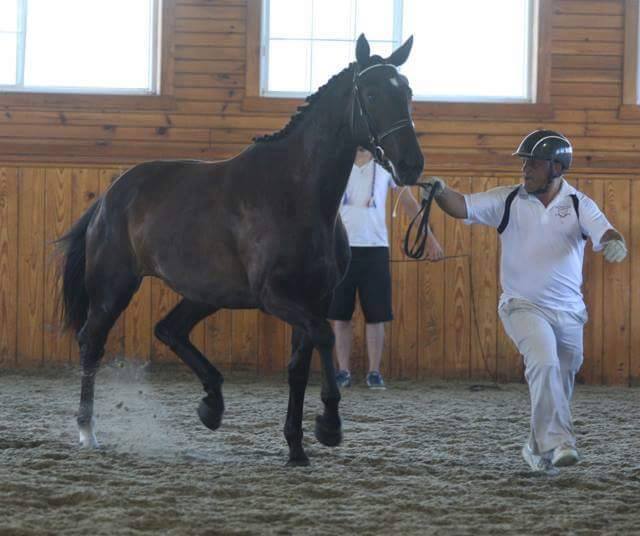Introducing Your Future Event Horse to the Half-Halt

The Young and Future Event Horse article series is being provided through a partnership between Mythic Landing Enterprises, LLC., and the USEA.
Phil Silva is a household name in the world of professional sporthorse handling after handling many champions at Dressage at Devon, NEDA and other various breed shows throughout the United States over the past 10 years. In 2014 Silva was awarded the prestigious John “JP” Perry Memorial Perpetual Trophy at Dressage at Devon, which is given to the person that exhibits true sportsmanship and is an ambassador for equestrian sports. Silva’s philosophy of patience and establishing trust and communication on the ground has made him one of the most in-demand sporthorse handlers and clinicians in the country.
Last winter Silva traveled to Ocala, Florida to be a part of the two-day USEA Future Event Horse (FEH) symposium where he demonstrated how to properly show a horse to the best of its ability. “As far as handling goes, it truly is the foundation of training the horse. You need to know your horse extremely well on the ground before you should even consider sitting in the saddle,” Silva remarks.
Silva explains that one of the most important training tools that you need on the ground in order to show your horse properly is the half-halt. This is imperative when showing your youngster in the Future Event Horse program because if your horse begins to overpower you with their outside shoulder, the triangle formation cannot be shown properly.
Silva explains that teaching the young horse about space is very, very important. When beginning to teach your horse this concept, he suggests holding a whip in your right hand with the reins or lead rope in your left and ask them to back up by applying slight pressure on their chest from the whip. Once they take that first step back, give them a pat.
Once your horse understands that the whip pressure means to back up, it’s time to introduce the next step. Silva suggests now switching the whip to your left hand and holding the lead rope or reins with the right hand.
“As you move your hands forward to be next to their muzzle, that should be their cue to walk up. If your horse starts to walk or trot too fast and starts moving in front of you, use your whip to lightly tap their chest—the same cue that you did before to make them back up. I’ve found that this provides the half-halt without them getting stronger because I’m not pulling on the reins,” describes Silva.

Phil Silva presenting a young horse. Photo courtesy of Phil Silva.
Silva continues that handling is really all about timing. You want to show the horse off as best as you can without any interference. Any time that you pull on the reins or the lead, the horse’s hind legs stop moving forward. The more that you can train your horse to respond to your body language, the more successful they’ll be in the ring.
As for the future of the program, Silva would love to see more handlers encouraged to participate. Silva would love to see handlers being scored along with their horses. He believe this will not only encourage increased participation in the program, but it will only better serve the horses as well, as the more educated handlers that you have, the more educated riders start to become because they learn how to truly train horses from the ground up.
To learn more about Phil Silva and his program, please visit his website at: http://tenbroeckfarm.net/index.html














